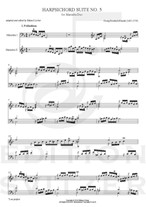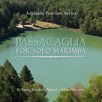
Suite No. 5 in E major
Composer: Georg Friedrich Händel / arr. Edzard Locher
Instrument: Marimba Duo
Level: Advanced
Published: 2022
Price: €20.00
Item details
-
Description +
-
Preface
This score (there are no individual parts) displays Georg Friedrich Händels (1685-1759) Suite No.5 in E major for Harpsichord HWV 430 (1720) as an arrangement for Marimba Duo.
Although different sources exist, this is solely based on and faithful to the edition in „Hallische Händelausgabe“ provided by the german Händel-Society in 1955. However for simplification reasons and due to instrumental restrictions on the marimba several changes were made by the arranger (see below). It is warmly recommended to recollect the original edition when in doubt about any editorial choices or execution.
The whole piece was transposed half a note up from E major to F major, thus using the full range of the marimba.
Bars 21-24 in the first movement were originally written as half note chords with an indication saying Harpeggiando. The harpsichord player would then keep hitting the keys in a constant arppeggio to emulate sustain. This was translated to a „composed“ arpeggio crossing the hands of both marimba players.
In movement one bar 12 of the original print the upper line of marimba II is falsely notated one third higher. This mistake has been recognized by several editors before and was corrected in this arrangement.
The whole fourth movement was rewritten to start one quarter note earlier, not starting on the downbeat one but on an upbeat four.
The „traditional variant“ in Variation 5 doesn’t appear in any source. It’s transcribed from common practice among keyboard performers. Also the transitional runs connecting or deviding the variations are either cut or added according to performing tradition.
Individual voicing was reduced to two voices maximum per part. Thus gaining clarity and omitting the sustained notes impossible on the marimba.
Marimba II requires five octaves. Marimba I only once ever uses bass clef in bar 1 of the first movement going down to F. If this whole bar is played by Marimba II, even a 4 octave marimba is sufficient for Marimba I.
-
-
Instrumentation +
-
Two Marimbas
-
-
About the composer +
-
-
George Frideric (or Frederick) Handel was a German, later British, Baroque composer who spent the bulk of his career in London, becoming well known for his operas, oratorios, anthems, and organ concertos. Handel received important training in Halle and worked as a composer in Hamburg and Italy before settling in London in 1712; he became a naturalised British subject in 1727. He was strongly influenced both by the great composers of the Italian Baroque and by the middle-German polyphonic choral tradition.
_______________
Edzard Locher (born 1989 in Tettnang, Lake Constance) studied percussion, composition and pedagogy in Zurich. He was percussionist with Kiel Philharmonic and Hof Symphony and is principal percussionist with Hessen State Orchestra Wiesbaden since 2016 as well as an associate professor at Wiesbaden Music Academy. He composes works for percussion and has specialized in percussion arrangements of classical music.
-
-
-
Credits +
-
Painting: Halyna Zubchenko and Hryhorii Pryshedko:
“Blacksmiths of Modernity” (1974)
Front Cover Design: Nicola Lee
Photo: Christoph Risch
Engraving: Edzard Locher
Printed in Copenhagen, Denmark
Copyright © Edition SVITZER
www.editionsvitzer.com
-








